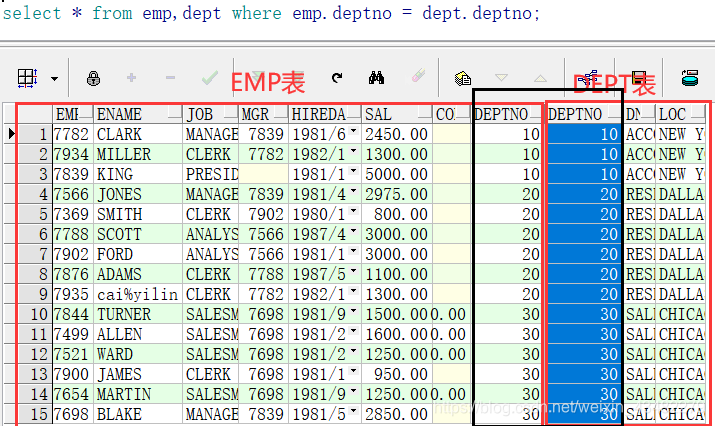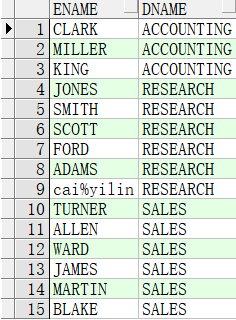多表查询
要想进行关联意味着两张表中必须包含相关联的字段。
多于两张表的连接:
为了连接n个表,至少需要n-1个连接。
sql:1992语法的连接
语法规则
SELECT table1.column, table2.column
FROM table1, table2
WHERE table1.column1 = table2.column2;
▪ 在 WHERE 子句中写入连接条件
▪ 当多个表中有重名列时,必须在列的名字前加上表名作为前缀
▪ 连接的类型:
- 等值连接 – Equijoin
- 非等值连接 – Non-equijoin
- 外连接 – Outer join
- 自连接 – Self join
92语法
数据来自于多张表 ,92表连接
▪ 注意: 明确引用同名的列,必须使用表名 或者别名区分
等值连接
等值连接,两个表中包含相同的列名。
例如,雇员表(emp)中的部门编号和部门表(dept)中的部门编号是一样的。select * from emp,dept where emp.deptno = dept.deptno;
所以可以查询雇员的名称和所属部门的名称:select ename,dname from emp,dept where emp.deptno = dept.deptno;
非等值连接
非等值连接,两个表中没有相同的列名,但是某一列在另一张表的列的范围之中【!= > < >= <= between and】
1 | --查询雇员名称以及自己的薪水等级 |
▪ select 字段列表 from 表1,表2,表3….
▪ where 表1.列!=表2.列 and 表1.列!=表3.列
外连接
在等值基础上,确保一张表(主表)的记录都存在。从表满足则匹配,不满足补充null
分类*:
▪ 1、左外连接: 主表在左边(把左表的全部数据显示)
▪ 2、右外连接: 主表在右边(把右表的全部数据显示)
1 | --需要将雇员表中的所有数据都进行显示,利用等值连接只会把关联到的数据显示, |


自连接:
自连接,特殊的等值连接。将一张表当成不同的表来看待,自己关联自己
1 | --将雇员和他经理的名称查出来 |
笛卡尔积
当关联多张表,但不指定连接条件的时候,会进行笛卡尔积。
关联后的总记录为m * n,一般不要使用
1 | select * from emp e, dept d; -- 16 * 4 = 64条 |
▪ 92的连接语法有什么问题???
92语法中,多张表的连接条件会放到方法where子句中,同时where需要对表进行条件过滤,因此,相当于将过滤条件和连接条件揉到一起,太乱了,所以出现了99语法。
sql:1999语法的连接
▪ sql1992的语法规则暴露了这样的缺点:语句过滤条件和表连接的条件都放到了where子句中 。当条件过多时,联结条件多,过滤条件多时,就容易造成混淆。
▪ SQL1999修正了整个缺点,把联结条件,过滤条件分开来,包括以下新的TABLE JOIN的句法结构:
– CROSS JOIN
– NATURAL JOIN
– USING子句
– ON子句
– LEFT OUTER JOIN
– RIGHT OUTER JOIN
– FULL OUTER JOIN
– Inner outer join
▪ 两种语法的SQL语句没有任何限制,再公司中可以随意使用,但是建议使用99语法,不要使用92语法,SQL显得清楚明了。
CROSS JOIN(交叉连接)
等同于92语法中的笛卡尔积。少用它
1 | select * from emp cross join dept; |
NATURAL JOIN(自然连接)
相当于是等值连接,但是注意:不需要写连接条件,会从两张表中找到相同的列做连接。
▪ 当两张表中不具有相同的列名的时候,会进行笛卡尔积操作。所以规定上禁止在不具有相同的列名的时候使用NATURAL JOIN。
▪ 自然连接*跟92语法的自连接没有任何关系
▪ 自然连接的结果不保留重复的属性
1 | select * from emp e natural join dept d ;--自然连接的结果不保留重复的属性 |
ON子句
为了设置任意的连接条件或者指定连接的列,需要使用ON子句。
▪ 使用ON 子句可以将连接条件(on)与其它的查询条件(where)分开书写。
▪ on子句,可以添加任意的连接条件。
1 | --添加连接条件 相当于92语法中的等值连接 |
使用on创建连接三表连接
检索雇员名字、所在单位、薪水等级:这三个信息在三个表里面,
所以只能用多表联结
1 | select ename, dname, grade |
外连接
left (outer) join(左外连接),会把左表中全部数据正常显示,右表没有对应的数据直接显示空即可。outer可省略
right (outer) join(右外连接),会把右表中全部数据正常显示,左表没有对应的数据直接显示空即可。outer可省略
full (outer) join,相当于左外连接和右外连接的合集
内连接
inner join(内连接),两张表的连接查询,只会查询出有匹配记录的数据。也就是说,必须要有对应才能查出来。
1 | --left (outer) join |
USING子句
using,除了可以使用on表示连接条件之外,也可以使用using作为连接条件,但是此时连接条件的列不再归属于任意一张表。
▪ using子句引用的列在sql任何地方不能使用表名或者别名做前缀,基本不使用它。
1 | select * from emp e join dept d using(deptno); --deptno只显示一列,不保留重复的属性 |
子查询
SQL允许多层嵌套。子查询,即嵌套在其他查询中的查询
▪ 把子查询当作一张表来看待。外层的语句可以把内嵌的子查询返回的结果当成一张表使用。
– 子查询要用括号括起来
– 将子查询放在比较运算符的右边(增强可读性)
▪ 子查询分类:
1.单行子查询
返回一行记录
使用单行记录比较运算符
复杂的sql语句可以拆开来做。
1 | --查询有哪些人的薪水是在整个雇员的平均薪水之上的? |
2.多行子查询
返回多行记录
使用集合比较运算符
在多行子查询中使用in
1 | --我们要查在雇员中有哪些人是经理人? |
在多行子查询中使用some all
1 | --找出部门编号为20的所有员工中收入最高的职员? |
在From子句中使用子查询
1 | --求每个部门平均薪水的等级 |
分页
限制输出,limit,mysql中用来做限制输出的,但是Oracle中不是。
在Oracle中,如果需要使用限制输出和分页的功能,必须使用rownum,但是rownum不能直接使用,需要嵌套使用
1 | --求薪水最高的前5名雇员 |
理解:select * from emp e order by e.sal desc排好序后形成一张虚拟表,rownum相当于系统默认赋予的一个列名,放着排序的序号,但是不显。也不能直接:select * from emp e where rownum <= 5 order by e.sal desc;,这样只是将前五条进行了一个排序。
如果求薪水最高的第6到10名雇员,不能直接在where中用rownum > 5 and rownum <= 10来限制输出。
原因:因为rownum的值不是固定死的,而是随着变化而变化的。比如这道例子中,rownum>5会先进行一个截取,截取后前五条的编号就不存在了,然后把后面的往前递进(原来第六条变成了第一条…),然后再rownum<=10截取,就会出现问题。
可以进行如下操作:
1 | --可以多打印出rownum这一列,必须写t1.,不然查不出来 |
使用rownum的时候必须要在外层添加嵌套,此时才能将rownum作为其中的一个列,然后再进行限制输出。
易错例子
1、找出部门编号为20的所有员工中收入最高的职员
1 | --1.找出部门编号为20的所有员工的收入 |
第二步不要忘了约束条件e.deptno = 20
2、求平均薪水最高的部门的部门编号
1 | --1.部门平均薪水(t1) |
复杂的sql语句可以拆开来做。
3、求出部门编号为20的雇员名、部门名、薪水等级
1 | --方法一 |
可以使用on创建三表连接,不需要将3个变成2个,再进行关联,比较麻烦